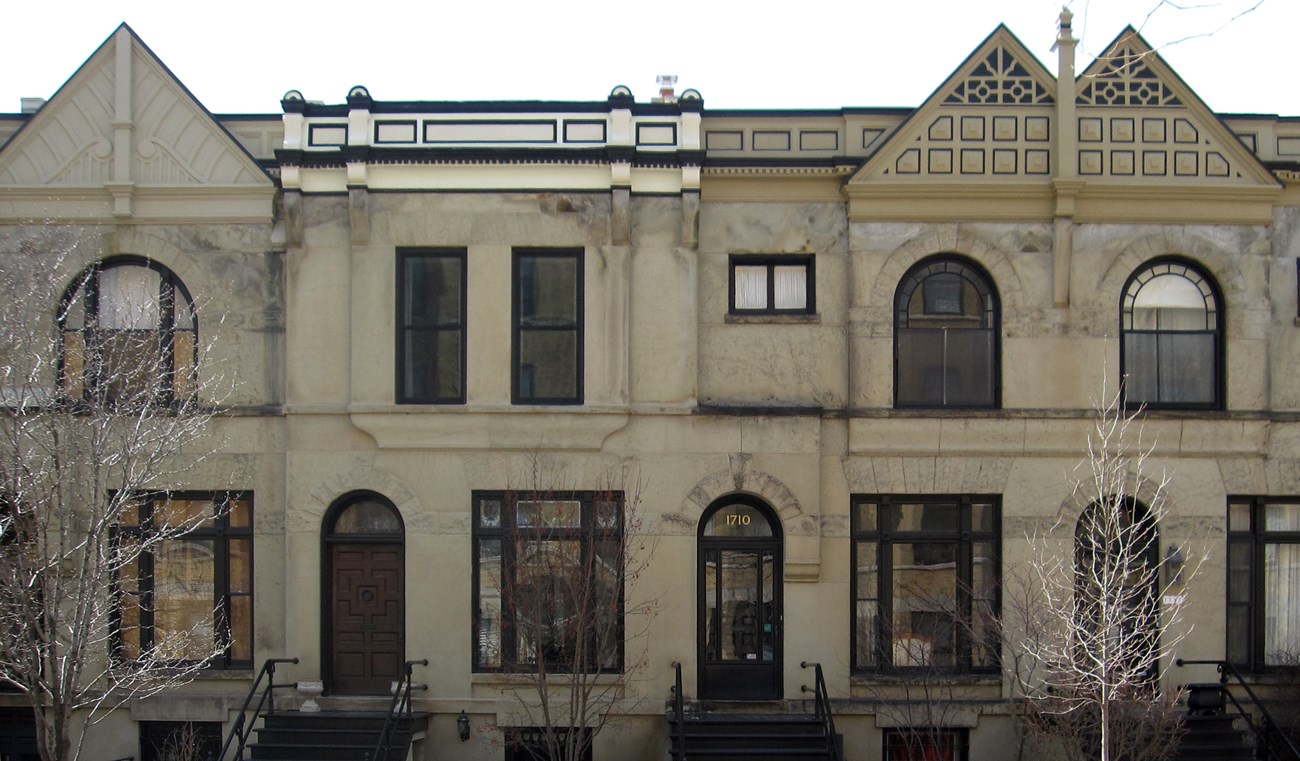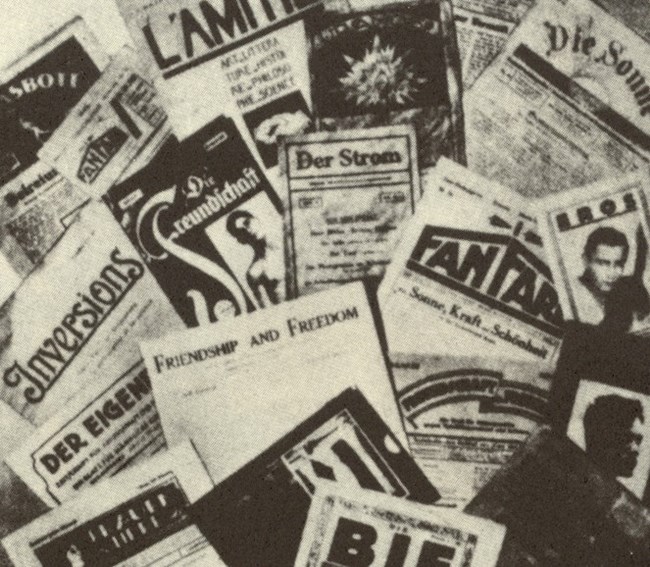Last updated: February 20, 2025
Article
Henry Gerber House National Historic Landmark

Photo courtesy of Shirley and Norman Baugher
Henry Gerber lived at 1710 North Crilly Court in Chicago, from 1924 to 1925. The then-boarding house served as the meeting place of the first official organization in the U.S. that advocated for homosexual equal rights—the Society for Human Rights—and it was also the location where the first homosexual periodical, Friendship and Freedom, was published. Gerber did not identify as homosexual in the earlier part of his life.
Henry Gerber was born on June 29, 1892 as Josef Heinrich Dittmar in Passau, Bavaria. He arrived at Ellis Island in October 1913. Upon immigrating to the United States at the age of 21, he, like many German immigrants, enlisted in the U.S. Army. When the U.S. declared war on Germany during World War I, Gerber declared himself a conscientious objector and for doing so was sent to an internment camp in Georgia. After being released, he then traveled to Chicago where he worked at Montgomery Ward’s Department Store.
Although it is impossible to identify when Gerber began to reconsider his sexual orientation, evidence suggests that post-war Germany profoundly shaped how he viewed homosexuality and influenced his later activism. He reenlisted in the army in 1919 after World War I and was stationed in Coblenz, Germany, where he worked as the writer and editor of the army newspaper, Amaroc. Gerber subscribed to several German homosexual periodicals.
The NHL nomination notes that Gerber made frequent trips to Berlin, and his experiences in Germany are attributed to the development of his world views. The political activism, medical discourse, and urban subcultures of German homosexuals impressed him deeply and informed his later vision for homosexuality in the United States and the goals of the Society of Human Rights.
Gerber named the Society for Human Rights after the Bund für Menschenrecht, or “League for Human Rights,” an association active in Germany in 1923. Organizations such as this one published their own periodicals—certainly an idea that Gerber took back to Chicago.
When Gerber returned to Chicago in 1923, he rented a room in a boarding house at 1710 North Crilly Court. He “found that the American scene lacked the respectability, political awareness, and scientific sophistication he had appreciated in Germany,” and therefore distanced himself from the Chicago homosexual scene. Although Crilly Court was not considered an established vice district, its large population of temporary lodgers and its accessibility to prostitution attracted those with “unconventional life-styles, sexual preferences, or political leanings.”
Additionally, 1710 North Crilly Court’s placement offered unforeseen advantages for Gerber’s lifestyle and activist plans, as it was located in the middle of a short, secluded street of row houses, with West Saint Paul Avenue and West Eugenie Street bounding it perpendicularly at each end. Gerber probably rented the small bedroom on the second floor and the basement likely served as a meeting space for the Society.
Influenced by scientific and medical research, American ideas of homosexuality were changing. But, when Gerber founded the Society of Human Rights in 1924, laws against same-sex intimacy between males still existed from the colonial era and included excessive punishment. It is important to note that prior to the early twentieth century, homosexuality was defined as one’s behavior, not one’s identity. However, as urban homosexual cultures grew, suspicion, harassment, discrimination, and violence towards homosexuals increased simultaneously.
In this political and cultural climate, Gerber founded the Society for Human Rights on December 10, 1924. Inspired by the methodical homophile movement he had experienced in Germany, Gerber used ambiguous language to attain a charter from the state of Illinois for a non-profit corporation called the Society for Human Rights:
Thus, the society became the first official organization with the exclusive purpose being to advocate for homosexual civil rights in the United States. The official address of the society was 1710 North Crilly Court. Gerber’s goal was to gain the support of professionals, such as doctors, and “men of good reputation,” as he called them. Gerber’s quest was ultimately unsuccessful.
In this political and cultural climate, Gerber founded the Society for Human Rights on December 10, 1924. Inspired by the methodical homophile movement he had experienced in Germany, Gerber used ambiguous language to attain a charter from the state of Illinois for a non-profit corporation called the Society for Human Rights:
to promote and to protect the interests of people who by reasons of mental and physical abnormalities are abused and hindered in the legal pursuit of happiness which is guaranteed them by the Declaration of Independence, and to combat the public prejudices against them by dissemination of facts according to modern science among intellectuals of mature age. The Society stands only for law and order; it is in harmony with any and all general laws insofar as they protect the rights of others, and does in no manner recommend any acts in violation of present laws nor advocate any matter inimical to the public welfare.
Thus, the society became the first official organization with the exclusive purpose being to advocate for homosexual civil rights in the United States. The official address of the society was 1710 North Crilly Court. Gerber’s goal was to gain the support of professionals, such as doctors, and “men of good reputation,” as he called them. Gerber’s quest was ultimately unsuccessful.

Hirschfield, magnus. Homosexual Periodicals of the 1920s. 1927. The Homosexual Movement in Germany. By James D. Steakley. New York: Arno, 1975. 79. Print.
Only two issues of Friendship and Freedom were ever produced, and no copies are known to survive today. However, a photograph published by Magnus Hirschfield in 1927 pictures Friendship and Freedom among several other European homosexual periodicals. The only other known evidence of the Gerber’s newsletter is a review that was published in April 1925 in the French journal L’Amitié. The review describes the first issue of Friendship and Freedom as including an article on “self-control,” a poem by Walt Whitman and an essay about Oscar Wilde. It also explains that the subscription fees were dedicated to a fund that would provide general assistance for homosexuals. However, the Society had trouble finding subscribers to its newsletter. Gerber later explained that “Most [homosexuals] feel that as long as some homosexual sex acts are against the law, they should not let their names be on any homosexual organization’s mailing list any more than notorious bandits would join a thieves’ union.”
The Society of Human Rights dissolved abruptly when Henry Gerber and several other members were arrested. Surviving accounts and evidence suggest that the police did not have a warrant to arrest Gerber nor to confiscate all of his belongings, including his typewriter, Society writings, and personal diaries. Eventually the court ordered the return of Gerber’s property, but he only received his typewriter—his writings and diaries were lost. Due to his arrest and the nature of the charges, the Post Office fired him on August 13, for “conduct unbecoming a postal employee.”
After the disbandment of the Society, Gerber was more secretively involved in the movement, sending letters to the editor of newspapers, keeping correspondence with other homosexuals, and running a pen pal club, which created a network of intellectual thinkers. Gerber continued to publish a significant number of articles throughout the 1930s and 1940s in periodicals such as American Mercury, The Modern Thinker, The Freethinker, Chanticleer, and in Washington D.C. newspapers on topics ranging from Theism and Atheism to Hitlerism and Homosexuality.
He received an honorary discharge from the army in 1945 and moved to the U.S. Soldiers’ and Airmen’s Home in Washington, D.C., where he resided until his death at age 80 in 1972. During these years in Washington, he remained in contact with other homosexual activists. In 1961, the Mattachine Society created a chapter in Washington, D.C., where Gerber became a member. Although he was alive when the Stonewall riots occurred in New York’s Greenwich Village in 1969, which signaled the modern gay movement, there is no evidence to suggest that Gerber was involved or even knew of it.
The NHL site at 1710 North Crilly Court retains a high degree of integrity, as does the surrounding residential area. The house is a single family, brick and masonry, row house, built by Daniel Francis Crilly in 1885 in the Queen Anne style. The Gerber House is located between West Saint Paul Avenue and West Eugenie Street in the Chicago district known as Old Town. The property became a boarding house at the beginning of World War I, as was the trend at the time.
Because artifacts of gay and lesbian history are so frequently lost or hidden, the Henry Gerber House stands as an exceptional example of a tangible place of American LGB History. Gerber’s story represents “the earliest documented efforts toward homosexual rights in America and the pervasive trend of discrimination against, and persecution of, homosexuals in the twentieth century.” (NHL Executive Summary)
Originally published in "Exceptional Places" Vol. 10, 2015, a newsletter of the Division of Cultural Resources, Midwest Region. Written by Kimberly A. Herman.
NHL nomination prepared by the University of Michigan Public History Initiative.
